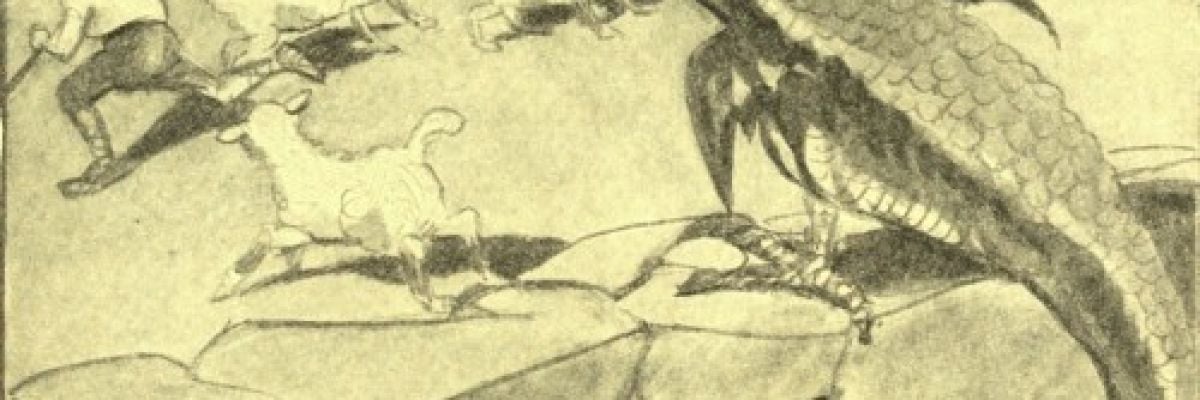
This creature is mentioned several times in the King James Version of the Bible. According to the author of the Skeptics Annotated Bible, “A cockatrice is a serpent, hatched from a cock’s egg, that can kill with a glance. They are rare nowadays.” Of course, Wells is being facetious and thinks the cockatrice is evidence that the Bible is not divinely inspired but is merely a man-made collection of fables.
Is he right?
The Cockatrice in the KJV
In the KJV the cockatrice is found in the books of the prophets. Jeremiah 8:17 says, “For, behold, I will send serpents, cockatrices, among you, which will not be charmed, and they shall bite you, saith the Lord.” Isaiah 11:8 says, “And the sucking child shall play on the hole of the asp, and the weaned child shall put his hand on the cockatrice’ den.” Bible critic Jason Long says of this creature, “The prophet Isaiah informs us that a cockatrice, a mythical creature able to kill its victim with a casual glance, will arise from a serpent (Isaiah 14:29). What tangible evidence do we have to believe that a creature with this incredible ability has ever existed?”[i]
But Long is mistaken because Isaiah never mentions the “cockatrice” nor does he describe this creature as having supernatural powers. Like the King James Bible in whose pages it is found, the cockatrice is a legendary product of medieval Europe and would have been unknown to prophets like Jeremiah or Isaiah. According to English scholar Laurence Breiener, “The cockatrice, which no one ever saw, was born by accident toward the end of the twelfth century and died in the middle of the seventeenth.”[ii]
Snakes, why’d it have to be snakes?
Although allusions to this creature can be traced back to Pliny the Elder, the 14th century dissident Catholic John Wycliffe was the first to use the term “cockatrice” in his popular translation of the Bible. It was later used in the 1535 Coverdale Bible, which may have been the source for the KJV’s use of this word.
Isaiah and Jeremiah would have been unaware of the “cockatrice,” but they would have known what a tsepha‘ was. This is the original Hebrew word used in passages like Jeremiah 8:17 and Isaiah 11:8 and it simply means “snake” or “viper.”[iii] Today, most modern translations render passages like Isaiah 11:8 in this way, “the weaned child shall put his hand on the adder’s den [an adder is a kind of venomous snake].”
Another Biblical creature that could fall under the category of “mythical snakes” are the so called “fiery serpents” found in passages like Numbers 21:6 which says, “the LORD sent fiery serpents among the people, and they bit the people; and much people of Israel died.” What in the world is a fiery serpent? The Hebrew phrase is hasseraphim hannekhasim and, according to one commentary, the fire probably refers not to the snake itself but to, “the burning sensation and pain brought about by the lethal injection of venom through the serpent’s fangs.”[iv]
Go to the Source
I should point out that these and other examples of so-called “mythical creatures” in the Bible illustrate an important Bible-reading rule, “Check the original language.” Remember, the Bible was not written in 17th century English but in ancient Hebrew (along with some Aramaic and Greek) for the Old Testament (which was later translated into the Greek Septuagint) and ancient Greek for the New Testament.
This refutes objections raised by atheists like David Mills, who says of passages that seem to describe mythical animals, “in the newer, modern-language translations of the Bible, these ridiculous passages of Scripture have been dishonestly excised, rewritten or edited beyond recognition from their original translation in the King James.”[v]
But Mills is erroneously treating the KJV as if it were the original text of the Bible that modern translations try to hide.[vi] The truth is that newer translations are better than the KJV because they use earlier and better manuscripts, or they more accurately represent what the original Bible authors actually wrote.
This is why when we confront a text that is difficult we must examine what the inspired author originally said in Hebrew or Greek. By doing this we sometimes see that the original word used by the human author makes more sense than the word a later translator used in its place, especially if the translation is an older one like the KJV.
[i] Jason Long. Biblical Nonsense: A Review of the Bible for Doubting Christians (iUniverse, 2005), 159.
[ii] Laurence Breiner. “The Career of the Cockatrice” Isis Vol. 70 No. 1 (1979) 30.
[iii] See Strong’s Concordance 6848
[iv] Dennis Cole. Numbers: An Exegetical and Theological Exposition of Holy Scripture (Holman Reference, 2000) 347.
[v] David Mills. Atheist Universe (Ulysses Press, Berkeley, CA, 2006) 150.
[vi] Ironically, Mills makes the same mistake as the extreme fundamentalists he argues against in his defense of atheism. These fundamentalists, or so-called “King-James Only” advocates like Peter Ruckman, believe that the KJV is the only inspired Word of God, even more so than the original Hebrew and Greek manuscripts of the Bible. For a good treatment of this issue see D. A. Caron’s The King James Version Debate: A Plea for Realism (1979)



